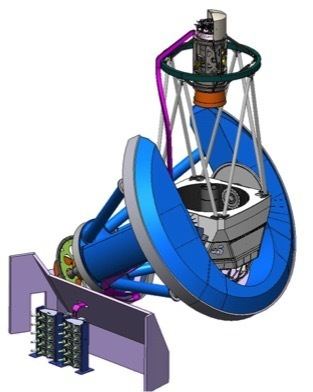Altitude 2,100 m (6,900 ft) First light 2019 (planned) | Wavelength 360–980 nm | |
 | ||
Location(s) KPNO, Tohono O’odham Nation, AZ, United States Built Construction started 2015 | ||
The "Mid-Scale Dark Energy Spectroscopic Instrument" (DESI) is a new instrument funded by the U.S. Department of Energy Office of Science and currently under construction. It will be located at 6880 ft. on the Mayall Telescope on top of Kitt Peak in the Sonoran Desert 55 miles distance from Tucson, Arizona. The new instrument will enable an experiment to probe the expansion history of the Universe and the mysterious physics of dark energy.
Contents
Science goals
The expansion history and large-scale structure of the Universe is a key prediction of cosmological models, and DESI observations will permit scientists to probe diverse aspects of cosmology, from dark energy to alternatives to General Relativity to neutrino masses to the early Universe. The data from DESI will be used to create three-dimensional maps of the distribution of matter covering an unprecedented volume of the Universe with unparalleled detail. This will provide insight into the nature of dark energy and establish whether cosmic acceleration is due to a cosmic-scale modification of General Relativity. DESI will be transformative in the understanding of dark energy and the expansion rate of the Universe at early times, one of the greatest mysteries in the understanding of the physical laws.
DESI will measure the expansion history of the Universe using the baryon acoustic oscillations (BAO) imprinted in the clustering of galaxies, quasars, and the intergalactic medium. The BAO technique is a robust way to extract cosmological distance information from the clustering of matter and galaxies. It relies only on very large-scale structure and it does so in a manner that enables scientists to separate the acoustic peak of the BAO signature from uncertainties in most systematic errors in the data. BAO was identified in the 2006 Dark Energy Task Force report as one of the key methods for studying dark energy. In May 2014, the High-Energy Physics Advisory Panel, a federal advisory committee, commissioned by the US Department of Energy (DOE) and the National Science Foundation (NSF) endorsed DESI.
3D map of the Universe
The baryon acoustic oscillations method requires a three-dimensional map of distant galaxies and quasars created from the angular and redshift information of a large statistical sample of cosmologically distant objects. By obtaining spectra of distant galaxies is it possible to determine their distance, via the measurement of their spectroscopic redshift, and thus create a 3-D map of the Universe. The 3-D map of the large-scale structure of the Universe also contains more information about dark energy than just the BAO and is sensitive to the mass of the neutrino and parameters that governed the primordial Universe. During its five-year survey beginning in September 2019, the DESI experiment will observe 35 million galaxies and quasars.
Instrument design
The DESI instrument will implement a new highly multiplexed optical spectrograph on the Mayall Telescope. A new optical corrector design creates a very large, 8.0 square degree field of view on the sky, which combined with the new focal plane instrumentation will weigh approximately 20,000 lbs. The focal plane accommodates 5,000 small computer controlled fiber positioners on a 10 millimeter pitch. The entire focal plane can be reconfigured for the next exposure in less than two minutes while the telescope slews to the next field.
The instrument fabrication is managed by the Lawrence Berkeley National Laboratory. Construction on the new instrument started in 2015. Funding is provided by the Department of Energy Office of Science, the National Science Foundation, the Science and Technology Facilities Council of the U.K., by the Gordon and Betty Moore Foundation, by the Heising-Simons Foundation, and by collaborating institutions worldwide.
